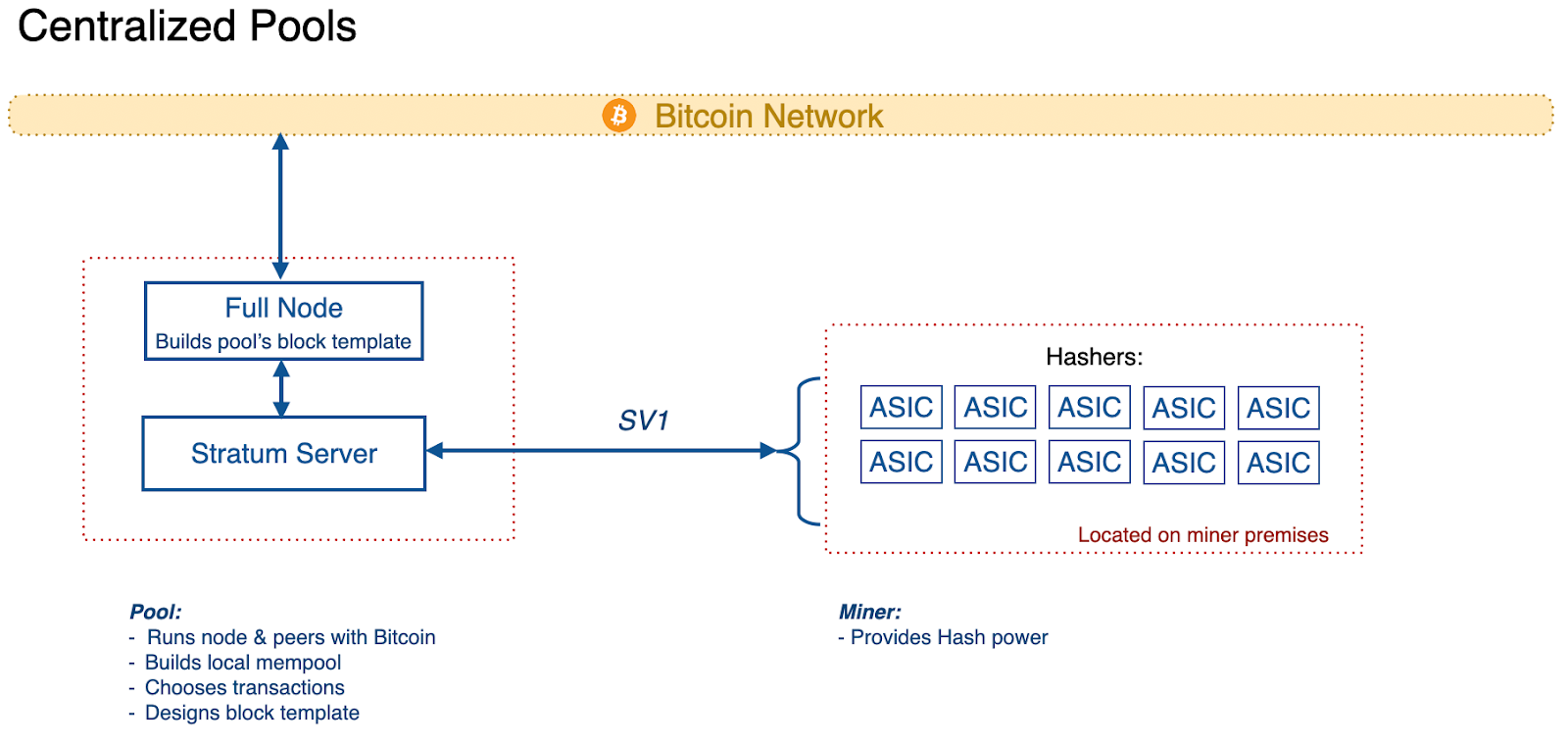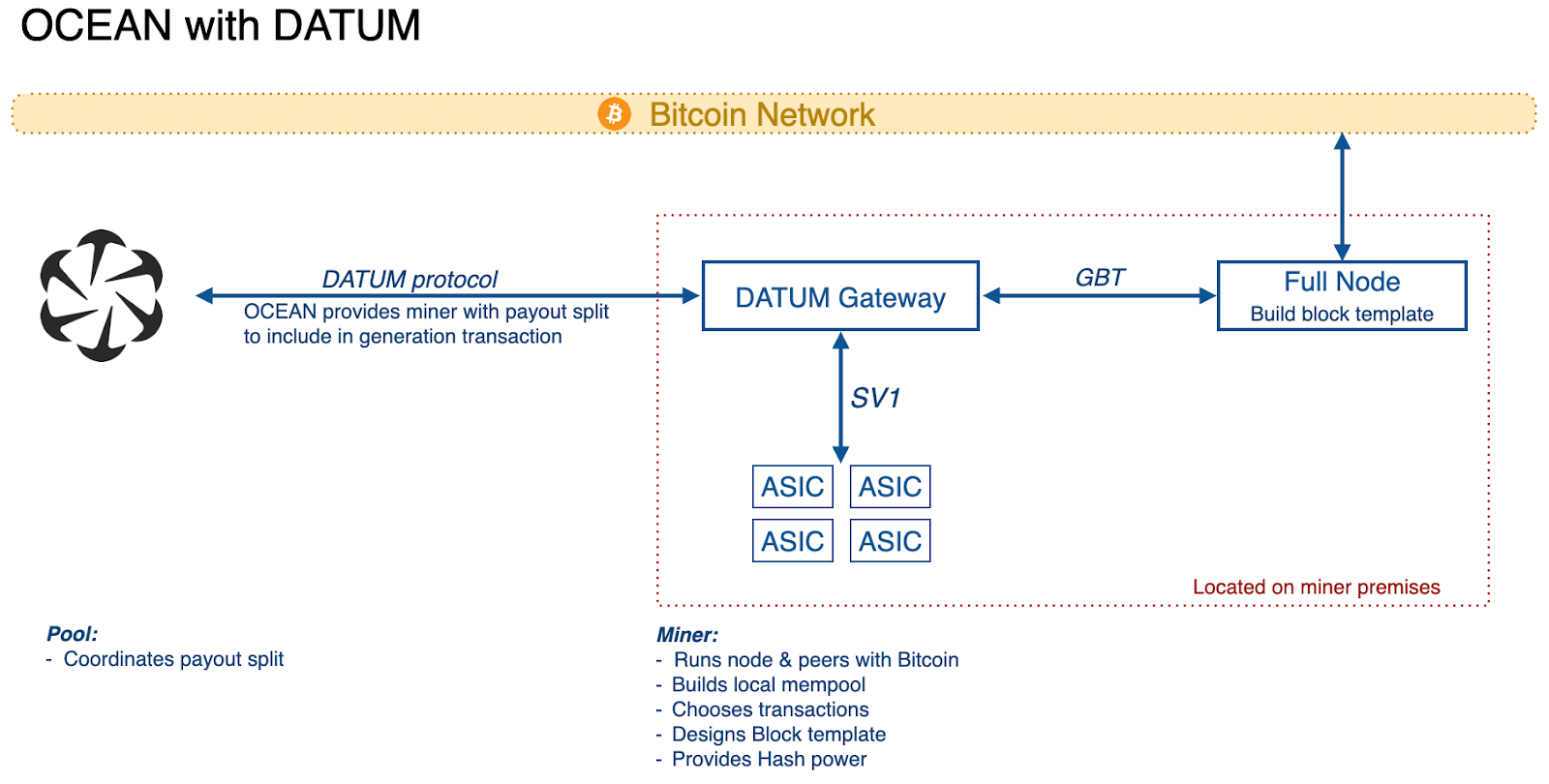Read about setting up DATUM here.
DATUM was born out of a need to restore Bitcoin mining to its decentralized roots—a time when miners truly embodied the role of building the blockchain by constructing block templates and submitting them to the network. Over the years, mining has drifted toward centralization, with large pools dominating the process and reducing miners to mere sellers of hash power. DATUM seeks to bring back the core principle of Bitcoin: decentralization, giving miners direct control over the block construction process once again.
Initially, we considered Stratum V2 (Sv2), a protocol that promised to address some of these issues. However, after a long development period, it became clear that Sv2 wouldn't be a viable solution in the near term. Further technical challenges convinced us that a new framework was necessary. This led us to create DATUM—a protocol built from the ground up to return power to the miners and restore the decentralized nature of Bitcoin.
In Bitcoin's early days, mining was a solo endeavor. Nodes acted as both miners and keepers of the ledger. The original Bitcoin software had a simple button labeled “Get Bitcoin,” which launched the process of mining directly on your computer. Finding a block would earn you 50 BTC, along with any transaction fees. However, as the network grew and the difficulty of mining increased, solo mining became less viable, leading to the birth of mining pools.
The first pools, like Slush (now Braiins) and Eligius, solved this problem by aggregating miners' hash rates, enabling more frequent and predictable payouts. However, a new problem emerged: pools, not miners, began constructing the block templates. Over time, this centralized control of the transaction selection process, concentrating power in the hands of a few large pools.
This centralization of block template construction has reached a dangerous peak. If a handful of pools control more than 51% of the network's hash rate, they could theoretically censor transactions, undermining the very principles of Bitcoin.

Figure 1. Mining workflow with centralized pool
OCEAN, the parent pool behind DATUM, exists to challenge this centralized mining landscape. Our mission is simple: return control of block templates to the miners, as it was intended in Satoshi's whitepaper. By doing so, DATUM ensures that miners, not pools, decide which transactions get added to the blockchain.
This is not just a theoretical risk—Bitcoin's security is directly tied to decentralization. If major pools were to censor transactions from specific entities, Bitcoin would lose its legitimacy. DATUM is designed to prevent this, putting the power back into the hands of the individual miners, those running both nodes and mining hardware.
At the heart of Bitcoin's success is incentive. Like gravity guiding the flow of water, incentive drives the security and decentralization of the network. With DATUM, we sought to strike a balance: how could miners remain part of a pool, benefiting from regular payouts, while still constructing their own blocks and participating fully in the Bitcoin ecosystem?
The answer lies in allowing miners to maintain control over block templates while still earning rewards from the pool. The block reward is only part of the equation—what really matters is blockspace, the ability to decide which transactions fill each block. Miners using DATUM can prioritize their transactions, even tailoring their mining efforts to benefit specific communities. For instance, a country like El Salvador could dedicate its mining resources to support its citizens with lower fees and prioritized access to blockspace.
DATUM solves a key problem in mining: variance. A miner may only find a block once a week, which can lead to inconsistent revenue. DATUM's integration with OCEAN ensures steady payouts while allowing miners to work toward constructing their own ideal blocks, thus reducing variance without compromising decentralization.
To further incentivize decentralization, DATUM miners receive a 50% discount on the OCEAN pool fee.
To use DATUM, miners will need a DATUM gateway, which communicates directly with their mining hardware, and a Bitcoin full node to peer with the Bitcoin network and manage block submissions. The gateway and full node can co-exist on the same hardware device. This allows miners to instruct their mining hardware on which work to perform, while OCEAN’s pool tracks contributions and reward splits accurately. Figure 1 (above) shows mining workflow with centralized pools, and Figure 2 (below) shows workflow with DATUM. With the exception of coordinating the payout split, all mining tasks have moved back to the miners giving them full control over the block design.

Figure 2. Decentralized mining with DATUM
DATUM is revolutionary because it offers the first fully decentralized mining protocol since Eligius shut down in 2017. While Stratum V2 includes some decentralized elements, it's bolted onto the original centralized design, resulting in inefficiencies. In contrast, DATUM was built from scratch with decentralized template construction in mind. It provides enterprise-level stability, high efficiency, and true decentralization—all while maintaining the security and encryption standards introduced by Stratum V2.
Perhaps most importantly, with DATUM, coinbase payouts go directly to miners, instantaneously and without custodial oversight. This ensures that every block found is rewarded in a decentralized, non-custodial manner—something no other pool or protocol offers.
The origins of DATUM trace back to 2012 when OCEAN co-founder Luke Dashjr began working on a solution to decentralize mining. The technology wasn't ready at the time, but today, with more powerful miners in the hands of individual users, we can pool resources to wrest control back from the dominant mining pools.
DATUM enables individuals to validate the network on their own, run their own nodes, and mine their own blocks, all while sharing in the rewards of the pool. This decentralized approach reduces risk and variance for miners while empowering them to construct the blocks they want—making DATUM a key player in the future of Bitcoin mining.
DATUM is not just another protocol; it's the next step in Bitcoin's evolution. By decentralizing block construction and securing the network against 51% attacks, DATUM keeps Bitcoin aligned with its original vision: a decentralized, secure, and free system. The future of Bitcoin mining depends on protocols like DATUM to ensure the network remains in the hands of the many, not the few.
